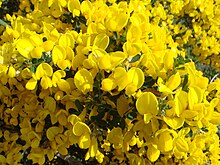
The peanut, also known as the groundnut, goober (US), goober pea, pindar (US) or monkey nut (UK), is a legume crop grown mainly for its edible seeds. It is widely grown in the tropics and subtropics by small and large commercial producers, both as grain legume and as an oil crop. Atypically among legumes, peanut pods develop underground leading botanist Carl Linnaeus to name peanuts hypogaea, which means "under the earth".

Maclura pomifera, commonly known as the Osage orange, is a small deciduous tree or large shrub, native to the south-central United States. It typically grows about 8 to 15 metres (30–50 ft) tall. The distinctive fruit, a multiple fruit, is roughly spherical, bumpy, 8 to 15 centimetres (3–6 in) in diameter, and turns bright yellow-green in the fall. The fruits secrete a sticky white latex when cut or damaged. Despite the name "Osage orange", it is not related to the orange. It is a member of the mulberry family, Moraceae. Due to its latex secretions and woody pulp, the fruit is typically not eaten by humans and rarely by foraging animals. Ecologists Daniel H. Janzen and Paul S. Martin proposed in 1982 that the fruit of this species might be an example of what has come to be called an evolutionary anachronism—that is, a fruit coevolved with a large animal seed dispersal partner that is now extinct. This hypothesis is controversial.

Sesame is a plant in the genus Sesamum, also called simsim, benne or gingelly. Numerous wild relatives occur in Africa and a smaller number in India. It is widely naturalized in tropical regions around the world and is cultivated for its edible seeds, which grow in pods. World production in 2018 was 6 million tonnes, with Sudan, Myanmar, and India as the largest producers.

Cercis canadensis, the eastern redbud, is a large deciduous shrub or small tree, native to eastern North America from southern Michigan south to central Mexico, west to New Mexico. Species thrive as far west as California and as far north as southern Ontario. It is the state tree of Oklahoma. The prevalence of the so-called "Columbus strain" has seen the residents of Columbus, Wisconsin, embrace the plant in their city's identity. Known as the "Redbud City," the town hosts "Redbud Day" annually the Saturday before Mother's Day, organizing a variety of themed events to recognize the tree.

The carob is a flowering evergreen tree or shrub in the Caesalpinioideae sub-family of the legume family, Fabaceae. It is widely cultivated for its edible fruit, which takes the form of seed pods, and as an ornamental tree in gardens and landscapes. The carob tree is native to the Mediterranean region and the Middle East. Portugal is the largest producer of carob, followed by Italy and Morocco.
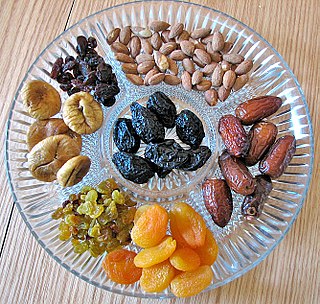
Dried fruit is fruit from which the majority of the original water content has been removed either naturally, through sun drying, or through the use of specialized dryers or dehydrators. Dried fruit has a long tradition of use dating back to the fourth millennium BC in Mesopotamia, and is prized because of its sweet taste, nutritive value, and long shelf life.
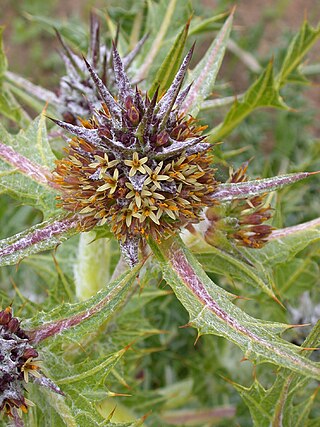
Gundelia or tumble thistle is a low to high (20–100 cm) thistle-like perennial herbaceous plant with latex, spiny compound inflorescences, reminiscent of teasles and eryngos, that contain cream, yellow, greenish, pink, purple or redish-purple disk florets. It is assigned to the family Asteraceae. Flowers can be found from February to May. The stems of this plant dry-out when the seeds are ripe and break free from the underground root, and are then blown away like a tumbleweed, thus spreading the seeds effectively over large areas with little standing vegetation. This plant is native to the eastern Mediterranean and the Middle-East. Opinions differ about the number of species in Gundelia. Sometimes the genus is regarded monotypic, Gundelia tournefortii being a species with a large variability, but other authors distinguish up to nine species, differing in floret color and pubescence. Young stems are cooked and eaten in the Middle-East and are said to taste like a combination of artichoke and asparagus.

Scolymus is a genus of annual, biennial or perennial, herbaceous plants that is assigned to the family Asteraceae, and can be found in Macaronesia, around the Mediterranean, and in the Middle East. All species are spiny, thistle-like in appearance, with flowerheads that consist of yellow ligulate florets, and canals that contain latex. It is sometimes called golden thistle or oyster thistle, and is known as سكوليمس (skwlyms) in Arabic and scolyme in French.

The Valley of Elah, Ella Valley, or Wadi es-Sunt, is a long, shallow valley in the Shephelah area of Israel, best known from the Hebrew Bible as the place where David defeated Goliath. It is home to several important archaeological sites, including those identified as the ancient towns of Azekah and Socho. Rising up from the valley on its extreme southeast end lies the hilltop ruin Adullam, and on its north lie the ruins of the ancient fortress city of Khirbet Qeiyafa, which is identified with the ancient town of Sha'araim.

Diospyros virginiana is a persimmon species commonly called the American persimmon, common persimmon, eastern persimmon, simmon, possumwood, possum apples, or sugar plum. It ranges from southern Connecticut to Florida, and west to Texas, Louisiana, Oklahoma, Kansas, and Iowa. The tree grows in the wild but has been cultivated for its fruit and wood since prehistoric times by Native Americans.
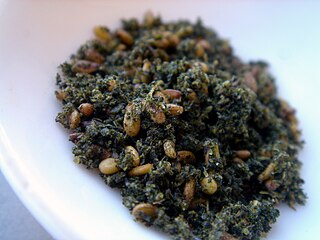
Za'atar is a Levantine culinary herb or family of herbs. It is also the name of a spice mixture that includes the herb along with toasted sesame seeds, dried sumac, often salt, and other spices. As a family of related Levantine herbs, it contains plants from the genera Origanum (oregano), Calamintha, Thymus, and Satureja (savory) plants. The name za'atar alone most properly applies to Origanum syriacum, considered in biblical scholarship to be the ezov of the Hebrew Bible, often translated as hyssop but distinct from modern Hyssopus officinalis.

Citrullus colocynthis, with many common names including Abu Jahl's melon, colocynth, bitter apple, bitter cucumber, egusi, vine of Sodom, or wild gourd, is a poisonous desert viny plant native to the Mediterranean Basin and West Asia, especially the Levant, Turkey, and Nubia.

Moringa oleifera is a fast-growing, drought-resistant tree of the family Moringaceae, native to the Indian subcontinent and used extensively in South and Southeast Asia. Common names include moringa, drumstick tree, horseradish tree, or malunggay.

Calicotome spinosa, the thorny broom or spiny broom, is a very spiny, densely branched shrub of the family Fabaceae which can reach up to three metres in height. It grows in the Western Mediterranean region on sunny slopes and dry, rocky ground. It is found in Spain, France, Italy, Croatia, Morocco, Tunisia, Libya, Algeria and Turkey, and it has been introduced to New Zealand. From March to June it produces bright yellow flowers which are borne singly or in small clusters. The seed-pods are 30mm long and are almost hairless, unlike those of the similar species Calicotome villosa.
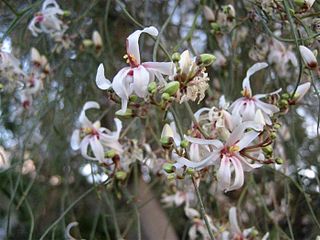
Moringa peregrina is a species of flowering plant in the family Moringaceae that is native to the Horn of Africa, Sudan, Egypt, the Arabian Peninsula, and as far north as Syria. It grows on rocky wadis and on cliffs in drier areas.

Ozothamnus ferrugineus, commonly known as tree everlasting, is a member of the genus Ozothamnus, of the Asteraceae family – one of the largest families of flowering plants in Australia. Native to the Australian states of New South Wales, Victoria, South Australia, and Tasmania, it forms an erect shrub or small tree between 2 and 3 metres in height.

The Gibraltar Nature Reserve is a protected nature reserve in the British Overseas Territory of Gibraltar that covers over 40% of the territory's land area. It was established as the Upper Rock Nature Reserve in 1993 under the International Union for Conservation of Nature's category Ia and was last extended in 2013. It is known for its semi-wild population of Barbary macaques, and is an important resting point for migrating birds.

Nathan ben Abraham, known also by the epithet President of the Academy in the Land of Israel, was an 11th-century rabbi and exegete of the Mishnah who lived in Ramla, in the Jund Filastin district of the Fatimid Caliphate. He was the author of the first known commentary covering the entire Mishnah.
Couepia polyandra, also known as olosapo, zapote amarillo, baboon cap, and monkey cap, is a flowering tree in the family Chrysobalanaceae.

Delphinium peregrinum, also commonly known as violet larkspur, is a Eurasian flowering plant, belonging to the genus Delphinium, endemic to Turkey, the Eastern Mediterranean and Western Irano-Turanian region, bearing an erect, annual stem with glabrous compound leaves and reaching a height of 27–35 cm. The plant, which blossoms between April and August, bears five colorful sepals (calyx), petaloid, the posterior sepal spurred, the two lateral sepals and the two lower sepals without spurs; while the anterior sepals can either be fused or separated. The inflorescence (corollas) are sparsely arranged, irregular, and are borne on long pedicels subtended by bracts.
